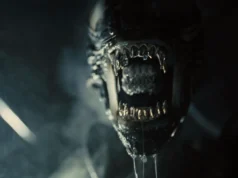“Goldthwait’s horror film ostensibly sounds like a recycled idea, but when one views it, they see an original portrayal of sound, perspective, and technique that prevails over cheap scares and dreary, commonplace events.”
Willow Creek is the closest a found footage film has come to replicating the quips, techniques, and storyline as the famous Blair Witch Project, but one of the only films I’ve seen to tread so close to the film and wind up being a strong and viable piece of work on its own. The film walks the line of being so similar it could be crippled by familiarity but it works so well in terms of establishing its own background that all similarities are recognized as just that – similarities drawn inside a greater landscape that allow the characters to play around at their own wishes and not be confined to found footage drudgery.
Everyone has a right to be skeptical with this film; we’ve been subjected to several found-footage films a year now and many of them have proven to be subpar reiterations of a formula that is clearly becoming winded and manipulated in order to increase profit margins for studios. The basic quips of the genre are lowlit environments, repetitive jump scares, flat characters, and a sometimes oppressively shaky camera that is already struggling to form some essence of clarity, showing indistinct, dark settings. Willow Creek, on the other hand, makes its film entirely about sound, perspective, and technique, which is why it succeeds. It doesn’t care if you’re scared; it cares whether or not you’re entertained.
The film revolves around a young couple named Jim and Kelly (Bryce Johnson and Alexie Gilmore), who venture out to Six Rivers National Forest in Humboldt County, California to find the shooting locations for the “Patterson–Gimlin film,” otherwise known as the famous Bigfoot video. Jim is devoted to finding and confirming the idea that Bigfoot is indeed real, while his girlfriend Kelly is more-or-less along for the ride to please her boyfriend and to hold the camera. Before entering Six Rivers, the two spend their time interviewing the locals of the neighborhood, such as gift shop owners and nearby townsfolk who have lived their whole lives knowing, embracing, and dealing with the legend of Bigfoot. These scenes work to remind us of how the three characters in The Blair Witch Project interviewed people in Maryland who were exposed to the legend of the Blair Witch. I am a fan of these scenes because we learn perspective and impact in a very naturalistic way.
- Willow Creek
- Written & Directed by
Bobcat Goldthwait - Cast
Alexie Gilmore, Bryce Johnson - Release Date
6 June 2014 - Steve’s Grade: A-
[widgets_on_pages id=”AdSenseArticleBanner”]
Not long after, we set course for the woods, and are thankfully not burdened by an unsteady camera. We see great shots of the deep woods in Northern California, all the while searching for the legend that is Bigfoot or any clues that may indicate he is real. When night falls, however, things take a turn for the worse in a way neither Jim nor Kelly expected. The two spend much of their night cooped up in their tenth, with one long, twenty-minute static camera shot of them hearing odd vocalizations and abrupt noises coming from every which way in the woods.
The twenty-minute static shot is never boring and poses an unflinching look at the characters’ lives inside this tenth in the middle of an unfamiliar woods. It’s startling how effective this long shot is, mainly because we get to hear great sound and sound effects that amplify such a chilling, uncomfortable mood, and we also get to see a rare perspective. Rather than editor Jason Stewart compiling disjointed, fragmented clips of scenes, resulting in a cacophonous array of cinematic madness, he allows this single shot to take prominence for a great deal of time, allowing for slowburn horror to build and so we’re not lost on what the characters are talking about the morning after. We’ve heard and seen as much as they have.
This kind of humanization of events takes place over traditional character development and I’m a-okay with that since this technique is much more superior than that of other found footage films. Willow Creek was directed by no other than Bobcat Goldthwait, who gave us the miraculous and biting social satire God Bless America just two years ago and returns to the screen with his first foray into horror filmmaking. I love Goldthwait as a director because he essentially takes ideas you could never see work into films (IE: two people – an adult and a teenage girl – running around a city killing the kind of people and celebrities that are allegedly ruining America and a woman recounting her one-time sexual encounter with her pet dog and how it has gone to have a lasting effect on her now) and make them not only good but great, memorable works. Goldthwait’s horror film ostensibly sounds like a recycled idea, but when one views it, they see an original portrayal of sound, perspective, and technique that prevails over cheap scares and dreary, commonplace events. This is the strongest horror film, thus far, in 2014 – on par with something recent horror film talents like Adam Wingard and Ti West would make.






